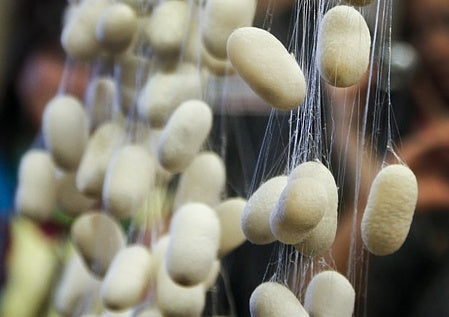Know Your Fiber: Silk
Posted on September 02 2017

The use of silk as a fiber is thought by most historians to have been developed in early China. Chinese legend has it that silk was discovered by Leizu, an empress in the 27th century BCE. As a popular version the story goes, Leizu was having a cup of tea one afternoon, and a silkworm cocoon fell from a mulberry tree into her hot tea. Apparently undisturbed by the cocoon in her tea, she watched as the silk fibers began to separate. Curious, she dipped in finger to capture the fibers, and found that she could wind them in a continuous fashion around her finger. Being a smart lady, Leizu immediately saw the potential and convinced her husband, the Yellow Emperor, to plant a grove of mulberry trees on which she began to cultivate silkworms. In this way, she began to cultivate silk in large enough quantities to create wearable fabric. Indeed, legend also credits her with inventing the silk reel to make thread, and with creating the first silk loom.
Who knows how true the legend is? It is possible Leizu was responsible for the discovery of silk or, as some folklorists and historians suspect, Leizu was an amalgamation of the many women and men who worked to create sericulture, or the cultivation of silk. It is hard to know from the writings and evidence we have available today just how early sericulture truly started. The earliest physical evidence of silk being used by humans is silk fabric from 3630 BCE, found wrapped around a child’s body at a Yangshao archeological site near Xingyang, Henan. Dyed silk cloth has also been found in tombs from the Zhou dynasty, which began in 1046 BCE.
Selling finished silk fabric and other products became very profitable for traders, and ultimately resulted in what we now call the Silk Road - a series of trade routes between Asia and Europe, that passed through the Indian subcontinent and the Middle East. Although many, many products made their way across this route, the silk trade is credited with being the driving force behind it. While other countries and cultures, such as those on the Indian subcontinent, already used wild silk to create fabric, the knowledge of sericulture helped China keep a monopoly on the silk trade. The Chinese emperors did what they could to keep the cultivation of silk a secret, making the exporting of silkworms or silkworm eggs punishable by death. Despite their best efforts, however, knowledge of sericulture began to spread. According to written records, it appears to have reached Korea by 200 BCE, India by 140 CE, and Japan by 300CE.
Silk fabric first began to reach Europe by the 4th century. According to written records, the first sericulture attempt in the Mediterranean was in 552, when the Byzantine emperor Justinian sent monks to China to smuggle back silkworm eggs hidden in sticks of bamboo. How successful this first attempt was is uncertain, but what we do know is that the silk industry of the Mediterranean mainly owed its success to various Arabs conquests that also spread sericulture across the region. By the 11th and 12th centuries, Italy had a very successful silk industry that provided silk across Europe. This didn’t stop imports from China, however. Silk was very much in demand.
Silk production began to spread across southern Europe, with Provence, France starting their sericulture industry by the 1500s. French sericulture continued to grow, experiencing significant success during the 18th and 19th centuries. Seeing the success that southern Europe was having with silk, Great Britain also tried to develop a silk industry. Unfortunately for the British, their cool and damp climate prevented any significant sericulture development.
Silk production may have continued to grow in Europe, had it not been for a variety of viral and fungal silkworm diseases that started to appear by 1845. Unsure how to manage these diseases, European silkworm cocoon production began to decrease, while the silkworm cocoon prices simultaneously increased. This coupled with a decrease in the price of Asian silkworm cocoon, thanks to the opening of the Suez Canal, led to an enormous decrease in the demand for, and production of, European produced silk.
Today, China is again the biggest producer of silk, with production in India coming in second. The silk products most readily available to knitters, crocheters, spinners and weavers largely come from cultivated silk, in which the silkworm farmers hatch Bombyx mori L. silkworm eggs, feed them mulberry leaves, and set a lattice over the worms, on which they spin cocoons.
An increasing number of crafters and fiber artists seek out and use wild or semi-domesticated silkworm fibers. Although there are over 500 species of wild silkworms in the world, there are only a few that provide enough silk so that it is available in the world market. Tussah, or Tussar, silk comes from Antheraea militate or Antheraea pernyi, which feed on the leaves from jamun or oak trees in India and China. Tussah silk is a very durable silk that is frequently a nice golden color from the high levels of tannins found in the leaves they eat. Muga silk is also highly prized. It comes from Antheraea assamensis silkworms, and is grown only in Assam, India. Muga silkworms feed on som and soalu plants, and their silk is a very light golden color, and is known for its gloss and durability. Another popular variety, Eri silk comes from Philosamia ricini silkworms, which are semi-domesticated. These silkworms feed on castor leaves or cassava leaves, and are raised in India and Thailand. Eri silk is referred to by some as Peace Silk, since the preferred gathering process involves collecting cocoons that have been vacated by their resident moths, rather than by steaming or boiling the cocoons with the silkworms inside. Eri silk can come in two natural colors: a white or a lovely red-orange.
Looking forward to working with some silk? Check out what we have available in-store or online in both yarns and spinning fiber!

Follow US